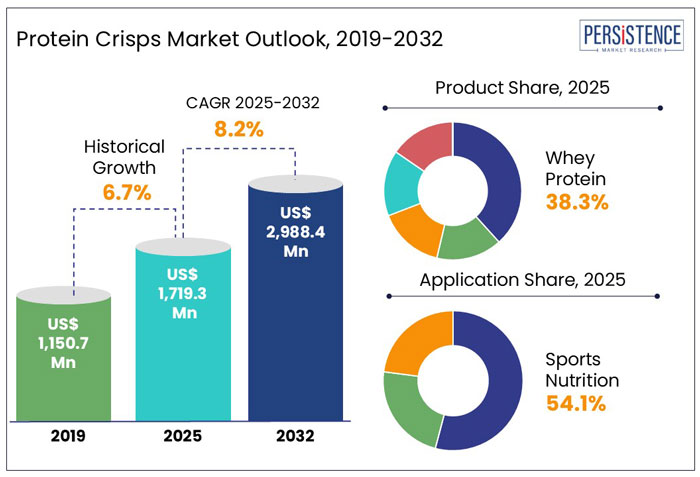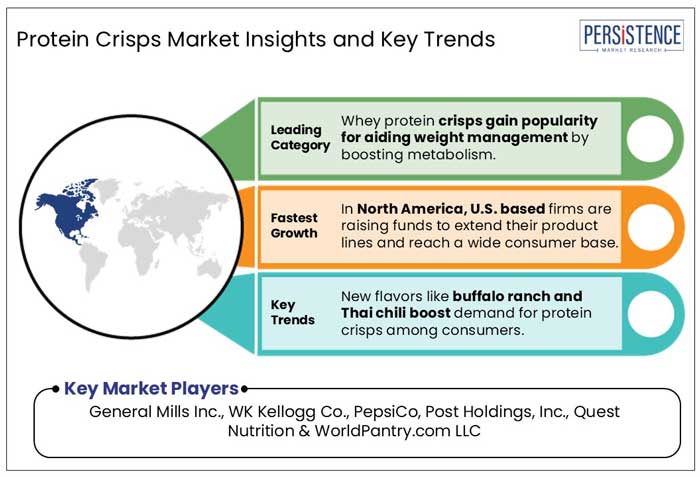Industry: Food and Beverages
Published Date: March-2025
Format: PPT*, PDF, EXCEL
Delivery Timelines: Contact Sales
Number of Pages: 185
Report ID: PMRREP30263
The global protein crisps market size is anticipated to reach a value of US$ 1,719.3 Mn in 2025 and is set to witness a CAGR of 8.2% from 2025 to 2032. The market will likely attain a value of US$ 2,988.4 Mn in 2032.
Protein-rich versions of conventional snacks are not a new concept for those individuals with muscle-building goals. After all, protein pudding and protein cookie dough recipes have gained popularity on TikTok and Instagram. Hence, it is not surprising that protein crisps have been made available, providing a delicious substitute for individuals who seek the benefits of protein.
Protein crisps are now considered an ideal way to increase the amount of protein in a meal plan that is otherwise low in the substance. These provide a similar flavor profile and texture to conventional snacks, but contain more protein, vitamins, and minerals. These are also more filling compared to other crunchy snacks and chips, thereby making these suitable for weight management.

Key Highlights of the Protein Crisps Industry
|
Global Market Attributes |
Key Insights |
|
Protein Crisps Market Size (2025E) |
US$ 1,719.3 Mn |
|
Market Value Forecast (2032F) |
US$ 2,988.4 Mn |
|
Projected Growth (CAGR 2025 to 2032) |
8.2% |
|
Historical Market Growth (CAGR 2019 to 2024) |
6.7% |
Protein Crisps Evolved from a Gym Goer’s Staple to a Mainstream Snack in the Historical Period
As per Persistence Market Research, in the historical period from 2019 to 2024, the global protein crisps industry witnessed a decent CAGR of around 6.7%. In 2019, protein crisps were at the nascent stage as these mainly catered to bodybuilders and fitness enthusiasts. The products had a limited market presence, with availability restricted to specific online platforms and specialty health stores.
Between 2020 and 2021, the COVID-19 pandemic resulted in the rising demand for functional, nutritious food items as consumers became increasingly conscious of their dietary choices. They demanded food items that would provide both health and taste benefits. Rising focus on health and fitness during lockdowns pushed the need for protein crisps. This was the period when several brands started launching new products to cater to general consumers apart from gym-goers.
Protein crisps witnessed developments in terms of flavors and ingredients between 2022 and 2023 with rising consumer preference for plant-based and clean label products. Brands like Hippeas launched lentil and pea-based protein crisps to tap into the plant-based food segment.
In 2024, protein crisps became a significant segment of the functional snacking market. Brands focused on eco-friendly packaging and ethical sourcing to keep up with ingredient transparency and sustainability norms. Various food corporations collaborated with or acquired small- and medium-sized protein crisp brands to co-develop new products and compete with independent brands.
Gas Stations and Convenience Stores to be Key Distribution Channels through 2032, Attracting Busy Consumers
From 2025 to 2032, the protein crisps market is likely to showcase a steady CAGR of 8.2%. Large-scale retailers and supermarkets are anticipated to recognize the trend for protein-rich diets through 2032. They are hence projected to broaden their snack offerings to include protein crisps. Reputed chains like Whole Foods, Target, and Walmart are set to launch innovative high-protein snack sections featuring Quest Nutrition and similar other brands.
Such a type of strategic placement is likely to propel impulse purchase as consumers searching for regular snacks are presented with healthier, high-protein items in the same section. Grocery delivery platforms like Amazon Fresh and Instacart are projected to make it easier for consumers to purchase new protein crisps online, bolstering their presence.
Gas stations and convenience stores have also become important distribution channels for these crisps. These are likely to cater to consumers looking for on-the-go, quick snack options. Various brands are anticipated to join hands with leading chains like Wawa, Circle K, and 7-Eleven to position their products in high-traffic areas. This strategy will likely help brands attract students, travelers, and busy professionals looking to consume a protein-packed snack on the go.
Emergence of Both Classic and Exotic Protein Crisp Flavors to Propel Demand among Consumers
Flavor innovation is projected to be a key factor propelling protein crisp demand worldwide. Even though demand for healthy items has surged, today’s consumers are not willing to compromise on taste. Conventional protein snacks often had a limited range of flavors and chewy texture. However, protein crisps provide a crunchy and light experience similar to normal chips.
It is anticipated to make these an ideal alternative for those demanding a balance between indulgence and nutrition. Manufacturers are projected to come up with new flavors, ranging from exotic ones like Thai sweet chili, jalapeño cheddar, and buffalo ranch to classic choices such as sour cream and onion and barbecue.
Manufacturers are also constantly experimenting with natural ingredients and seasoning techniques to improve the taste of their high protein crisps while maintaining an organic appeal. They are adopting aged cheese, spices, and real herbs to make rich and authentic flavors. For instance, Whisps offers a natural umami flavor by using real cheese in its protein crisps. PopCorners, on the other hand, blends bold seasonings like honey mustard with plant-based proteins to ensure consumers get flavorful bites.
Few Small-scale Brands May Use Artificial Preservatives to Extend Product Shelf Life, Hampering Sales
Even though the popularity of protein crisps has become high, there are a few cons that may hamper their appeal to specific consumers. To extend shelf life and improve texture, a few small-scale brands may use artificial preservatives, emulsifiers, and sweeteners in their crisps. This is anticipated to refrain some consumers from purchasing such products as they seek clean-label crisps.
Compared to regular crackers and chips, protein crisps are usually more expensive. The use of added nutrients, unique processing techniques, and high-quality protein sources often surge the manufacturing costs of protein crisps, making these less accessible for budget-conscious consumers. Compared to a regular pack of chips, a pack of protein crisps may cost 2 to 3 times more. This cost variation is projected to limit adoption among casual snackers who are otherwise not strictly focused on high-protein diets.
Brands to Launch Soy Protein Crisps Catering to Those Living with Lactose Intolerance
Healthy snack brands are projected to get new opportunities by launching soy protein crisps as these cater to the surging demand for high-protein, plant-based items. These crisps are anticipated to appeal to a broad consumer base, including individuals living with lactose intolerance.
It is set to encourage brands to extend their product lines and strengthen their position globally. Key players like Origin and SimplyProtein, for instance, offer soy-based protein crisps to attract consumers preferring plant-based items. Several other brands are focusing on extending their presence across North America and Europe where consumers are constantly looking for high-protein diets.
Whey Protein to be Demanded due to Awareness of its Benefits in Muscle Building and Recovery
Whey protein will likely generate a share of around 38.3% in 2025. Whey protein crisps are predicted to gain immense popularity due to rising awareness among modern consumers regarding their potential health benefits in weight management, muscle building, and recovery. Apart from that, a neutral flavor profile and palatable texture of several whey protein crisp formulations is anticipated to make these an ideal ingredient for preparing confectionery items, and cereals.
Another prominent factor boosting the segment is the presence of a well-developed infrastructure for the production of whey protein worldwide. Food companies are anticipated to gain easy access to whey protein and integrate it into either existing or new product ranges. The robust supply chain is projected to help ensure consistent availability and cost-effectiveness.
Pea protein, on the other hand, is set to showcase a considerable growth rate through 2032. It is attributed to rising consumer preference for allergen-friendly, vegetarian, and vegan products. Pea protein crisps are likely to witness skyrocketing demand among those consumers looking to lower their meat consumption for health and environmental reasons.
As pea protein is naturally soy-free, dairy-free, and gluten-free, it is set to be considered a key ingredient for products made for consumers with certain dietary sensitivities or restrictions. The unique ‘pea’ flavor and grainy texture of earlier generations of pea protein crisps drew a lot of criticism. However, innovative extrusion and extraction techniques have eliminated these issues, resulting in the development of a more satisfying crunchy texture and neutral flavor.
Athletes to Increasingly Demand Palatable Protein Crisps to Enhance Hunger Control
Sports nutrition segment is projected to hold a share of about 54.1% in 2025. Athletes and fitness enthusiasts are constantly demanding palatable and convenient protein sources, which is set to create a high demand for protein crisps. These are considered ideal for managing hunger between meals, supporting weight management goals. Also, these help surge protein intake among athletes by preventing the dependency on large portions of dairy and meat.
Key companies are set to launch new protein crisps to provide a convenient on-the-go option for post- and pre-workout sessions. Rising popularity of demanding exercise regimens like CrossFit and high-intensity interval training (HIIT) is set to propel the need for efficient protein intake, further bolstering sales. Developments in protein crisps like those with natural flavors and sweeteners, as well as improved amino acid profiles are likely to push demand among gluten-free or vegan athletes.
The weight management segment, on the other hand, is predicted to witness considerable growth through 2032. Increasing awareness of the significance of dietary protein in maintaining lean muscle mass during weight loss is projected to surge the segment. Launch of protein crisps with low sugar and carbohydrate content is also set to appeal to specific consumers looking for low-carb and ketogenic diets to manage their weight.

U.S.-based Companies to Focus on Bagging Funds to Enhance Brand Awareness and Reach Potential Consumers
North America is anticipated to generate a share of nearly 38.4% in 2025. This is attributed to rising inclination of consumers toward protein-rich alternatives to potato chips that are considered unhealthy.
The U.S. protein crisps market is anticipated to create new growth avenues in North America in the foreseeable future. Several brands in the country are focusing on raising funds to extend their offerings and distribution channels, providing easy access to potential consumers.
Nashville-based WILDE, a protein snack brand, for example, successfully raised around US$ 20 Mn in a round led by KarpReilly in April 2024. The fund helped raise brand awareness as more consumers in the U.S. looked for nutrient-rich food items to maintain their health. The company provides a wide range of flavored chips that include 10 grams of protein from bone broth, egg whites, and chicken breast.
Brands in Japan to Launch Innovative Crisp Packaging to Attract Specific Consumer Segments
In Asia Pacific, Japan is estimated to showcase steady growth as consumers move toward nutritious and functional snacking options. Various consumers in the country are seeking healthy items like protein crisps to maintain a balanced diet.
Unlike traditional senbei or rice crackers, these crisps offer a higher protein content, thereby attracting health-conscious consumers. Several local snack brands are striving to launch new products in unique packaging to gain a broad consumer base.
Hananomi, a Japan-based snack brand, for instance, announced in February 2025 that it is focusing on balanced protein and fat intake for effective energy conversion by targeting consumers with moderate activity levels. The company plans to launch warrior-inspired packaging depicting the female shinobi and the samurai.
It aims to denote improved energy levels for working through the day with the new packaging of its Power Chips range. This innovative packaging idea would appeal to both current health trends in Asia Pacific and cultural curiosity toward Japan.
India protein crisps market will likely witness the launch of a wide range of products catering to the varying demands of consumers. In November 2024, for example, Origin Nutrition introduced a new line of compression-popped, high-protein pea-based chips. It targeted the slow-but-sure local healthy snacking industry. Similar new product launches are anticipated to propel the market through 2032.
Clean-label Trend in Germany to Propel Demand for Crisps Made from High-quality Protein Sources
In Europe, the U.K. is projected to remain at the forefront of growth. As per a survey conducted by Holland & Barrett International Limited, a multinational chain of health food shops based in Nuneaton, every year, around 6 Bn packets of crisps are collectively consumed in the U.K. alone. Traditional crisps usually come with high calorie and fat content as these are made from corn and potato.
Protein crisps are hence gaining traction in the country as these are considered healthier than their traditional counterparts. Consumers are looking for brands that offer unique products catering to their dietary needs.
Myprotein, a bodybuilding supplement brand, headquartered in the U.K., for example, launched protein crisps in two new flavors back in June 2024. These crisps were baked to lower calories and designed to be high in protein. Each 25g pack offered around 10g of protein. The brand aimed to reach consumers looking for an ideal pre- or post-workout snack.
In Germany, on the other hand, the clean-label trend is anticipated to transform purchasing patterns. Consumers are now seeking healthy items made with high-quality protein sources, minimal additives, and natural ingredients.
Various protein crisp brands in the country are hence providing non-GMO, vegan, and gluten-free products to cater to a wide range of dietary preferences. Brands like Foodspring and Layenberger, for example, have already launched protein crisps targeting both casual snackers and athletes in the country.
The global market for protein crisps is highly competitive with the presence of various large- and small-scale companies. They are focusing on launching new products in the market to target a wide consumer base. A few renowned companies are striving to acquire small-scale protein snack brands to strengthen their position, especially in the better-for-you category.
|
Report Attributes |
Details |
|
Historical Data/Actuals |
2019 - 2024 |
|
Forecast Period |
2025 - 2032 |
|
Market Analysis Units |
Value: US$ Bn/Mn, Volume: As applicable |
|
Geographical Coverage |
|
|
Segmental Coverage |
|
|
Competitive Analysis |
|
|
Report Highlights |
|
|
Customization and Pricing |
Available upon request |
By Product
By Application
By Distribution Channel
By Region
To know more about delivery timeline for this report Contact Sales

The market is set to reach US$ 1,719.3 Mn in 2025.
The industry will likely be valued at US$ 2,988.4 Mn in 2032.
The industry is set to surge at a CAGR of 8.2% through 2032.
General Mills Inc., PepsiCo, Post Holdings, Inc., and WK Kellogg Co. are a few key companies in the industry.
Whey protein is projected to be the leading product in the global market in 2025.